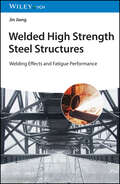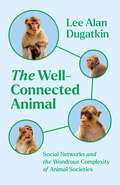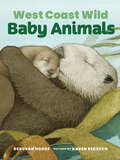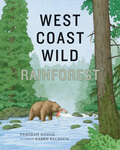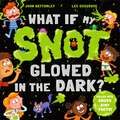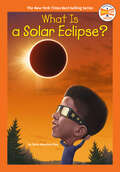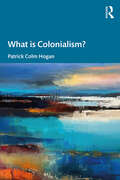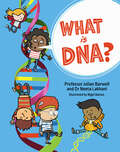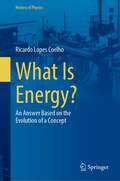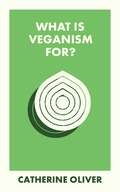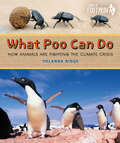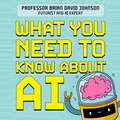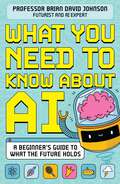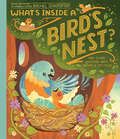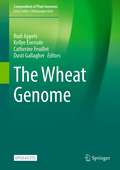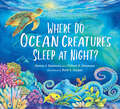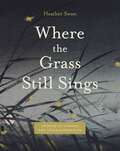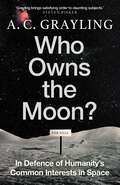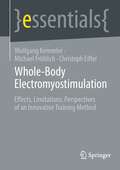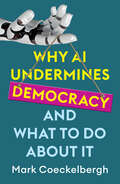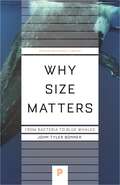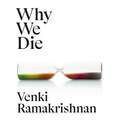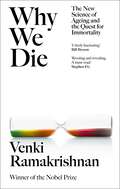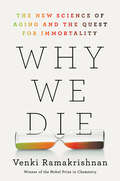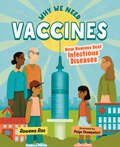- Table View
- List View
Welded High Strength Steel Structures: Welding Effects and Fatigue Performance
by Jin JiangWelded High Strength Steel Structures Understand the impact of fatigue on high strength steel joints with this comprehensive overview High strength steels are highly sought after for industrial and engineering applications ranging from armored vehicles to welded engineering components built to withstand considerable stress. The mechanical properties of welded joints made from high strength steel are integrally linked to the specific welding process, which can have an enormous impact on fatigue performance. Welded High Strength Steel Structures: Welding Effects and Fatigue Performance provides a comprehensive analysis of high strength steel joints and the ramifications of the welding process. It guides readers through the process of performing thermal analysis of high strength steel structures and evaluate fatigue performance in the face of residual stress. The result is a volume with innumerable use cases in engineering and manufacture. Welded High Strength Steel Structures readers will also find: An author with decades of experience in research and engineering Numerous studies of various classes of high strength steel joints Studies on tubular structures for welding residual stress Welded High Strength Steel Structures is a must-own for welding specialists, materials scientists, mechanical engineers, and researchers or industry professionals in related fields.
The Well-Connected Animal: Social Networks and the Wondrous Complexity of Animal Societies
by Lee Alan DugatkinAn engaging exploration of the wondrous social webs that permeate life in animal societies around the world. It’s all about who you know. Whether vampire bats sharing blood meals for survival, field crickets remembering champion fighters, macaque monkeys forming grooming pacts after a deadly hurricane, or great tit birds learning the best way to steal milk—it pays to be well connected. In this tour of the animal kingdom, evolutionary biologist Lee Alan Dugatkin reveals a new field of study, uncovering social networks that existed long before the dawn of human social media. He accessibly describes the latest findings from animal behavior, evolution, computer science, psychology, anthropology, genetics, and neurobiology, and incorporates interviews and insights from researchers he finds swimming with manta rays, avoiding pigeon poop, and stopping monkeys from stealing iPads. With Dugatkin as our guide, we investigate social networks in giraffes, elephants, kangaroos, Tasmanian devils, whales, bats, and more. From animal networks in Australia and Asia to Africa, Europe, and the Americas, The Well-Connected Animal is an eye-opening exposé of wild friends, enemies, and everything in between.
West Coast Wild Baby Animals (West Coast Wild)
by Deborah HodgeMeet the wild baby animals of the Pacific west coast! Wolf pups, bear cubs, whale calves and eaglets are thriving in the ancient rainforest, rugged beach and majestic ocean of the Pacific west coast. This sweet introduction to baby animal names and behaviours, with gorgeous watercolor scenes, will delight toddlers and babies everywhere! Key Text Features illustrations
West Coast Wild Rainforest (West Coast Wild #5)
by Deborah HodgeStep into the majestic rainforest of the Pacific west coast and discover a unique community of creatures thriving in an interconnected web of life. Towering over the sea, along the magnificent Pacific west coast, is an ancient and beautiful rainforest with a unique ecosystem that is linked in many ways. In this fourth book in the West Coast Wild series, you will find trees as tall as twenty-storey buildings, tiny seedlings sprouting on nursery logs and brightly colored salmon spawning in streams. The salmon, as a keystone species, connect the ocean to the forest and provide a rich source of food for the bears, wolves, eagles and other creatures that live in this pristine wilderness. The remains of the fish add vital nutrients to the forest, feeding the lush green plants and trees. In turn, the thick vegetation shades the streams and protects the baby salmon that hatch and swim to the sea. Author Deborah Hodge provides a clear and engaging look at the interdependence of the forest species and the fascinating cycles of nature in this rare ecosystem, while Karen Reczuch’s lavish watercolors show the rainforest teeming with life in shades of green that can only come from receiving more than ten feet of rain a year. Key Text Features illustrations author’s note further information further reading facts Correlates to the Common Core State Standards in English Language Arts: CCSS.ELA-LITERACY.RI.K.3 With prompting and support, describe the connection between two individuals, events, ideas, or pieces of information in a text. CCSS.ELA-LITERACY.RI.K.7 With prompting and support, describe the relationship between illustrations and the text in which they appear (e.g., what person, place, thing, or idea in the text an illustration depicts). CCSS.ELA-LITERACY.RI.1.3 Describe the connection between two individuals, events, ideas, or pieces of information in a text. CCSS.ELA-LITERACY.RI.1.4 Ask and answer questions to help determine or clarify the meaning of words and phrases in a text.
What If My Snot Glowed in the Dark?
by John BottomleyEverybody pees, poos and pukes, and everyone has icky skin and smells horrible. But have you ever wondered what would happen if your burps could power a hot air balloon? You could burp your way across the country! Or what if your farts smelled like roses? Well, you could grow a fart garden, or start a range of perfumes inspired by your farts. Or what if you never, EVER showered again? (Please, do make sure you shower regularly!) With plenty hilarious, yucky facts to discover about the gross stuff that comes out of you, budding young scientists - and comedians! - can learn all about why their bodies do icky, sticky things. What if My Snot was Glow in the Dark? really puts the FUN in bodily functions.
What Is a Solar Eclipse? (Who HQ Now)
by Dana Meachen Rau Who HQLearn about the phenomenon of a solar eclipse just in time for the Great American Eclipse that will take place on April 8, 2024 in this title in the Who HQ Now series featuring newsmakers and trending topics.Just in time for the third North American total solar eclipse of the twenty-first century, this book explains how to safely observe solar eclipses, how long eclipses last, and why they result in a blackout period during the day. Young armchair astronomers and astronauts will be inspired by the wonders of outer space and what exists beyond our atmosphere as they learn more about the moon, the sun, and our earth. What really happens during a solar eclipse and how does it affect the energy in our atmosphere? You'll find the most up-to-date eclipse information in this exciting new book.
What is Colonialism?
by Patrick Colm HoganWhat is Colonialism? develops a clear and rigorous account of what colonialism is and how it works. It draws on and synthesizes recent work in cognitive science, affective science, and social psychology, along with Marxism and related forms of analysis. Hogan begins with some fundamental conceptual distinctions, such as the degree to which a group shares beliefs, dispositions, and skills versus the degree to which they share identification with a category. Building on these distinctions, he defines colonialism in terms of political, economic, and cultural autonomy, clarifying the nature of culture and autonomy particularly. He goes on to articulate an invaluable systematic account of the varieties of colonialism. The final chapters outline the motives of imperialists, differentiating these from their ideological rationalizations, and sketching the harms caused by colonialism. The book concludes by considering when, or if, one can achieve a genuinely postcolonial condition. Hogan illustrates these analyses by examining influential literary works—by European writers (such as Joseph Conrad) and by non-Europeans (such as Athol Fugard, Kamala Markandaya, and Wole Soyinka). This accessible and informative volume is the ideal resource for students and scholars interested in colonialism and empire.
What is DNA?
by Professor Julian Barwell Dr Neeta LakhaniA humorous introduction to DNA and genetics, helping children find out what they are made of!DNA is the building block of all life. This book helps children aged 8 plus understand the structure of the DNA chemical, how it works inside the body, how life began on Earth and how all living things are connected by their DNA. With Nigel Baines' hilarious cartoons, the book explores topics such as why some of us really don't like Brussel sprouts - and why some of us love them!; what came first - the chicken or the egg?; and how DNA can solve crimes and make our lives better.Contents: The Great Discovery! / The Code Breakers and the Machines Inside Our Bodies / Babies Come with Instructions / Is it Good to Mix Up Our DNA? / How are Twins Made? / How Did Life on Earth Begin? / What Came First - the Chicken or the Egg? / Are We 50% a Mushroom?/ Is Grandad Really a Dinosaur?/ Why Don't I Like Vegetables?/ How Did I Get Ginger Hair?/ How Much Do Our Genes Affect Us?/ Spot a Relative After 500 Years!/ Traffic Lights - Red! Green! Blue?/ Gene On, Gene Off/ DNA That Makes Diseases / Who Did It!? / Who Is In Charge? / Quiz
What Is Energy?: An Answer Based on the Evolution of a Concept (History of Physics)
by Ricardo Lopes CoelhoThis book provides a solution to the problem with the energy concept. This problem manifests itself in the fact that physicists clearly diverge regarding the question of what energy is. Some define it but others state that we do not know what it is. Although this is a problem for physicists who need to explain the concept, it is not a problem for physics that can be solved by laboratory means. Penetrating into the origin of the notion of energy, this book offers a clear idea of what was discovered and what was invented to interpret the findings.Following the development of the concept, it provides an explanation of the trends in contemporary textbooks. The author's repetition, in his "History and Philosophy of Physics Laboratory", of Joule’s famous experiment – the paddle wheel experiment – with a calorimeter as originally used by Joule and with a calorimeter as proposed in textbooks, is presented, yielding new insight into the phenomenon. Thus, science teachers and students will benefit from reading the book as well as historians, philosophers, students of the history and philosophy of science, and all who are interested in knowing about what it is that we call energy.
What Is Veganism For? (What Is It For?)
by Catherine OliverAcross the world, an increasing number of people are turning to veganism, changing not just their diets, but completely removing animal products from their lives. For some, this is prompted by concerns over animal ethics; for others, it’s a response to the part played by animal agriculture in the climate crisis or an attempt to improve their own health. Catherine Oliver shows why the veganism movement has become a powerful social, political and environmental force, taking an honest look at how we live and eat. She discusses the health and environmental benefits of veganism, explores the practical and social impacts of the shift to eating plants, and explains why veganism is not just a diet, but a way of life.
What Poo Can Do: How Animals Are Fighting the Climate Crisis (Orca Footprints #29)
by Yolanda RidgeWe all know animals are affected by the climate crisis. But did you know the climate crisis is also affected by animals? From whales to dung beetles, What Poo Can Do explores how animals big and small are helping the planet every time they do a number two. Come on a journey to different parts of the world to see how animals are fertilizing plants, storing carbon, preventing fires, reducing methane and even creating color-coded maps—all through their feces! Readers will discover how animal defecation makes a difference when it comes to the climate crisis. It's time to embrace the power of poo!
What You Need to Know About AI: A beginner’s guide to what the future holds
by Brian David JohnsonThe only book you need on AI - for all curious, fact-gobbling kids age 7+.What actually is AI? Will it take over the world? And one day, will it tidy your bedroom...? In this beginner's guide, learn everything you need to know about AI, from how it helps us discover epic stuff up in space or under the sea, whether it will help you build your very own dinosaur, and why, it won't actually help you write your homework! Written by AI expert and Futurist, Brian David Johnson, you will learn what AI is, where it came from, and how it's already being used in the world of sport, space, medicine, animals and more. You will discover AI's amazing possibilities that might shape the future. And along the way, you'll learn super cool facts, bust some myths, and gain a balanced and informed view on the biggest topic of our time.Designed with fun line illustrations throughout.
What You Need to Know About AI: A beginner’s guide to what the future holds
by Brian David JohnsonThe only book you need on AI - for all curious, fact-gobbling kids.What actually is AI? Will it take over the world? And one day, will it tidy your bedroom . . .? In this beginner's guide, learn everything you need to know about AI, from how it helps us discover epic stuff up in space or under the sea to whether it might help you build your own dinosaur.With AI expert and futurist Brian David Johnson, discover what AI is, where it came from, the incredible ways it's being used today and how it might shape and reimagine your future. Learn that AI is just software and that it won't replace human creativity or imagination, but it could help us do some really cool things. And uncover amazing facts, myth busters and insight from experts around the world!This book offers a balanced, expert and fascinating view on the biggest topic of our time. Designed with fun illustrations throughout.
What's Inside A Bird's Nest?: And Other Questions About Nature & Life Cycles (What's Inside)
by Rachel IgnotofskyDiscover the next nonfiction picture book about eggs, nests, and birds from the creator of the New York Times bestseller Women in Science, Rachel Ignotofsky! Want to learn more about the bird that chirps outside your window? Ignotofsky crafts a perfect read out loud with a touch of humor and compassion for our friends with wings in the sky!Find out more from the moment they hatch, to how they create their homes in this perfectly detailed and soon-to-be springtime favorite read!Rachel Ignotofsky's beautiful, distinctive art style and engaging, informative text clearly answers any questions a child (or adult) could have about birds, eggs, and nests in this nonfiction picture book series.
The Wheat Genome (Compendium of Plant Genomes)
by Rudi Appels Kellye Eversole Catherine Feuillet Dusti GallagherThis open access book provides the first comprehensive coverage of the wheat genome sequence since the publication of the draft and reference sequences for bread wheat and durum wheat. It presents an overview and all aspects of the gold standard sequence of the bread wheat genome, IWGSC RefSeq v1.0 and its subsequent improvements through 2022 (IWGSC RefSeq v2.1), as well as the sequencing of multiple elite wheat varieties, durum wheat, and ancient wheat. The book provides a broad and extensive review of the resources, tools, and methodologies available for exploiting the wheat genome sequence for crop improvement and studying fundamental questions related to the structure, function, and evolution of the wheat genome. Wheat (Tritcum aestivum L.) is the most widely grown crop in the world, contributing approximately 20 percent of total calories and more protein in human diets than any other single source. This book is useful to students, teachers, and scientists in academia and industry interested in gaining an understanding of the wheat genome and its application as well as plant scientists generally interested in polyploid plant species.
Where Do Ocean Creatures Sleep at Night?
by Steven J. Simmons Clifford R. SimmonsOcean animals sleep, just like you! This informative, rhyming picture book dives deep to look at where and how ocean animals sleep in the sea.Many ocean animals are active during the day, but where and how do they sleep at night? From sharks to dolphins and sea turtles to octopuses, plus parrotfish and whales and more, discover what these ocean creatures do when it&’s time to go to sleep and the day is through.Where Do Ocean Creatures Sleep at Night? is newest addition to a three-book series, which includes Where Do Creatures Sleep at Night? and Where Do Big Creatures Sleep at Night? "Where Do Ocean Creatures Sleep at Night showcases wondrous watercolor illustrations that capture the allure of the sea. The rhyming rhythm dances through captivating animal facts about water-dwelling creatures before concluding in a cozy child's bedroom. Crafted to be a favorite bedtime read, this book is a must-have for the bookshelves of ocean lovers.&”– Bethany Stahl, Bestselling Author of Save the Ocean&“All mammals and most other animals need sleep, including those living in marine environments. This picture book&’s palette of soft colors and informative rhyme will introduce children to various facts about specific ocean animals and how they rest. Perfect for a bedtime read-aloud, this book will help young listeners and readers cuddle up together in their nice dry bed and sleep as tight as otters.&”– Sara T. Behrman, former librarian and author, The Sea Hides A Seahorse&“A delightful bedtime book! This jaunt into the ocean to learn about how our marine friends sleep will easily become part of your family bedtime routine. The charming illustrations are sure to captivate the imagination of children and inspire a love for the wonders of the sea, while sending them on a happy trip to dreamland.&” – Anne Richardson, Author of Octopuses Have Zero Bones and Chief Experience Officer at The Exploratorium "Scientific, sweet, and salty!"- Karen Romano Young, Deep Sea Diver and Award-winning Author of Whale Quest "This book is an absolute delight- the Dr. Seuss Sleep Book reimagined for the ocean. A beautiful way to unwind while learning a little more about our mysterious watery world. Where Do Ocean Creatures Sleep at Night? will surely inspire a future marine biologist or two!"- Paige Hoel, Ph.D. candidate, Oceanography, UCLA Atmospheric and Oceanic Sciences"A gorgeously illustrated children&’s book that will inspire the next generation of marine biologists, conservationists, and animal lovers. The accurate animal facts were a breath of fresh air to find in this genre and will make learning fun for children and adults alike!&”- Kristyn Plancarte, Marine Biologist and animal trainer&“Dive into an underwater world of wonder and imagination. This delightful read features stunning artwork that brings the ocean to life for bedtime. From playful dolphins to sleepy sea turtles, families will climb aboard an informative journey through the sea." - Kendra Nelson, Marine Conservationist
Where the Grass Still Sings: Stories of Insects and Interconnection (Animalibus)
by Heather SwanThrough narrative, verse, and art, Where the Grass Still Sings celebrates the many tiny creatures that play crucial roles in our ecosystems—as well as the people on the front lines of the fight to save them.Weaving art and science with inspiring stories of people doing their part to protect insects and the environment, author Heather Swan takes readers around the globe to highlight practical solutions to safeguard our fragile planet. Visit a sustainable coffee farm in Ecuador and a frog expert combating animal trafficking in Colombia. Explore a butterfly sanctuary in an Andean cloud forest and learn about a family of orchid farmers who are replanting a mountainside to attract native pollinators. Meet a bumblebee expert helping Wisconsin cranberry growers, a bark beetle specialist in a new-growth forest in Georgia, an entomologist collecting for the Essig Museum in California, and more. Against a backdrop of climate change, ecological injustice, and impending mass extinction, this book rekindles wonder and hope.Featuring works by artists deeply invested in preserving the smallest beings among us, Where the Grass Still Sings is a paean to the natural world.
Who Owns the Moon?: In Defence of Humanity's Common Interests in Space
by A. C. GraylingSilicon for microchips; manganese for batteries; titanium for missiles. The moon contains a wealth of natural resources. So, as the Earth&’s supplies have begun to dwindle, it is no surprise that the world&’s superpowers and wealthiest corporations have turned their eyes to the stars. As this new Space Race begins, A.C. Grayling asks: who, if anyone, owns the moon? Or Mars? Or other bodies in near space? And what do those superpowers and corporations owe to Planet Earth and its inhabitants as a whole? From feudal common land, through the rules of the sea, to the vast, nationless expanse of Antarctica, Grayling explores the history of the places which no one, and therefore everyone, owns. Examining the many ways this so-called terra nullius has fallen victim to &‘the tragedy of the commons&’ – the tendency for communal resources to be exploited by a few individuals for personal gain at the expense of everyone else – Who Owns the Moon? puts forward a compelling argument for a bold new global consensus, one which recognises and defends the rights of everyone who lives on this planet.
Whole-Body Electromyostimulation: Effects, Limitations, Perspectives of an Innovative Training Method (essentials)
by Wolfgang Kemmler Michael Fröhlich Christoph EiflerThis essential is intended as a compact reference for issues and aspects related to the innovative training technology of whole-body electromyostimulation (WB-EMS). In addition to background and information on WB-EMS application, in which the authors pay particular attention to safe and effective use, there is a current overview of research results summarizing the effects of WB-EMS on various target outcomes. Finally, a characterization of the market situation, current trends and a forecast of developments in the field of WB-EMS is presented.
Why AI Undermines Democracy and What To Do About It
by Mark CoeckelberghAcross the world, AI is used as a tool for political manipulation and totalitarian repression. Stories about AI are often stories of polarization, discrimination, surveillance, and oppression. Is democracy in danger? And can we do anything about it? In this compelling and balanced book, Mark Coeckelbergh reveals the key risks posed by AI for democracy. He argues that AI, as currently used and developed, undermines fundamental principles on which liberal democracies are founded, such as freedom and equality. How can we make democracy more resilient in the face of AI? And, more positively, what can AI do for democracy? Coeckelbergh advocates not only for more democratic technologies, but also for new political institutions and a renewal of education to ensure that AI promotes, rather than hinders, the common good for the twenty-first century. Why AI Undermines Democracy and What to Do About It is illuminating reading for anyone who is concerned about the fate of democracy.
Why Size Matters: From Bacteria to Blue Whales (Princeton Science Library #142)
by John Tyler BonnerJohn Tyler Bonner, one of our most distinguished and creative biologists, here offers a completely new perspective on the role of size in biology. In his hallmark friendly style, he explores the universal impact of being the right size. By examining stories ranging from Alice in Wonderland to Gulliver's Travels, he shows that humans have always been fascinated by things big and small. Why then does size always reside on the fringes of science and never on the center stage? Why do biologists and others ponder size only when studying something else—running speed, life span, or metabolism?Why Size Matters, a pioneering book of big ideas in a compact size, gives size its due by presenting a profound yet lucid overview of what we know about its role in the living world. Bonner argues that size really does matter—that it is the supreme and universal determinant of what any organism can be and do. For example, because tiny creatures are subject primarily to forces of cohesion and larger beasts to gravity, a fly can easily walk up a wall, something we humans cannot even begin to imagine doing.Bonner introduces us to size through the giants and dwarfs of human, animal, and plant history and then explores questions including the physics of size as it affects biology, the evolution of size over geological time, and the role of size in the function and longevity of living things.As this elegantly written book shows, size affects life in its every aspect. It is a universal frame from which nothing escapes.
Why We Die: The New Science of Ageing and the Quest for Immortality
by Venki RamakrishnanA major exploration of the science of why and how we age and die - from a Nobel Prize-winning biologist and former president of the Royal Society.'Ramakrishnan's writing is so honest, lucid and engaging' - Siddhartha MukherjeeThe knowledge of death is so terrifying that we live most of our lives in denial of it. Our fear of death has underpinned our religions, inspired our cultures, and also driven our science. Today we are living through a revolution in biology. Giant strides are being made in our understanding of why we age and die, and why some species live longer than others. Immortality, once a faint hope, has never been more within our grasp.Here, Nobel Prize-winning biologist Venki Ramakrishnan offers a definitive look at why we die - and whether we can do anything about it. Covering the recent breakthroughs in scientific research, he examines the cutting edge of efforts to extend lifespan by altering our natural biology and how this raises profound questions. Although we might not like it, might death might serve a necessary biological purpose? And what are the social and ethical costs of attempting to live forever? As science advances, we have much to gain. But might we also have much to lose?Why We Die is a narrative of uncommon insight and beauty from one of our leading public intellectuals.(P) 2024 Hodder & Stoughton Limited
Why We Die: The New Science of Ageing and the Quest for Immortality
by Venki Ramakrishnan'Spectacular. It changed my perspective on the whole living world but most of all myself.' - CHRIS VAN TULLEKEN'Combines science, politics, memoir and medicine with ease, grace and lucidity. An incredible journey.' SIDDHARTHA MUKHERJEE'Utterly fascinating. Clear, enthralling and packed with insights.' - BILL BRYSON'A thrilling ride through the science of ageing and death. A must-read.' - STEPHEN FRY_________Would you want to live forever?Nobel Prize-winning molecular biologist Venki Ramakrishnan transforms our understanding of why we age and die - and whether there's anything we can do about it.We are living through a revolution in biology. Giant strides are being made in our understanding of why we age and die, and why some species live longer than others. Immortality, once a faint hope, has never been more within our grasp.Examining recent scientific breakthroughs, Ramakrishnan shows how cutting-edge efforts to extend lifespan by altering our natural biology raise profound questions. Although we might not like it, does death serve a necessary biological purpose? And how can we increase our chances of living long, healthy and fulfilled lives? As science advances, we have much to gain. But might we also have much to lose?
Why We Die: The New Science of Aging and the Quest for Immortality
by Venki Ramakrishnan"Utterly fascinating." —Bill Bryson"An incredible journey." —Siddhartha MukherjeeA groundbreaking exploration of the science of longevity and mortality—from Nobel Prize-winning molecular biologist Venki RamakrishnanThe knowledge of death is so terrifying that we live most of our lives in denial of it. One of the most difficult moments of childhood must be when each of us first realizes that not only we but all our loved ones will die—and there is nothing we can do about it.Or at least, there hasn’t been. Today, we are living through a revolution in biology. Giant strides are being made in understanding why we age—and why some species live longer than others. Could we eventually cheat disease and death and live for a very long time, possibly many times our current lifespan?Venki Ramakrishnan, recipient of the Nobel Prize in Chemistry and former president of the Royal Society, takes us on a riveting journey to the frontiers of biology, asking whether we must be mortal. Covering the recent breakthroughs in scientific research, he examines the cutting edge of efforts to extend lifespan by altering our physiology. But might death serve a necessary biological purpose? What are the social and ethical costs of attempting to live forever?Why We Die is a narrative of uncommon insight and beauty from one of our leading public intellectuals.
Why We Need Vaccines: How Humans Beat Infectious Diseases (Orca Timeline #6)
by Rowena RaeVaccination is one of humanity's most effective and greatest discoveries. Infections like the plague, smallpox and other deadly diseases have affected and killed people for thousands of years, but the invention of vaccines forever changed our relationship with these diseases. More recently the urgency of developing an effective vaccine during the COVID-19 pandemic brought vaccination to the public's attention. Simmering tensions around vaccine hesitancy, misinformation and mistrust of science came to the forefront. Although an earlier form of protection against infectious diseases has been practiced for a long time, vaccines have only been around for 200 years. Why We Need Vaccines explores the history of vaccine discovery, the science of how vaccines work and the public-health achievements that vaccines have made possible. It also discusses vaccine mandates and inequality in access to vaccines on local and global scales. It challenges young readers to take responsibility for themselves, their families and their communities so we can all be part of the solution to take down infectious diseases.
